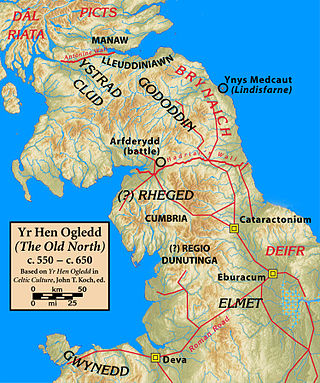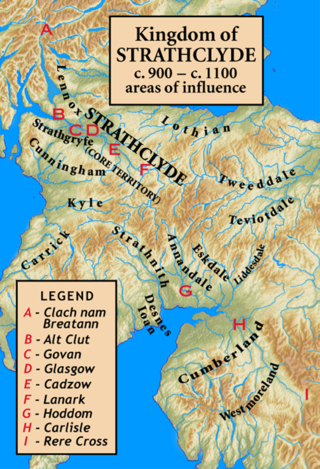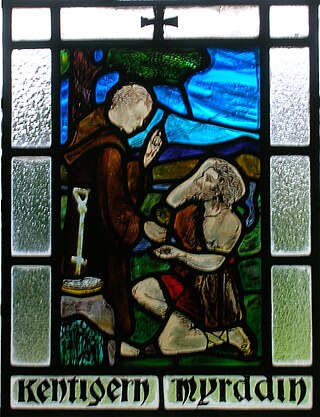
Rheged was one of the kingdoms of the Hen Ogledd, the Brittonic-speaking region of what is now Northern England and southern Scotland, during the post-Roman era and Early Middle Ages. It is recorded in several poetic and bardic sources, although its borders are not described in any of them. A recent archaeological discovery suggests that its stronghold was located in what is now Galloway in Scotland rather than, as was previously speculated, being in Cumbria. Rheged possibly extended into Lancashire and other parts of northern England. In some sources, Rheged is intimately associated with the king Urien Rheged and his family. Its inhabitants spoke Cumbric, a Brittonic dialect closely related to Old Welsh.

Strathclyde, was a Brittonic successor state of the Roman Empire and one of the early medieval kingdoms of the Britons, located in the region the Welsh tribes referred to as Yr Hen Ogledd, which comprised the Brythonic-speaking parts of what is now southern Scotland and northern England. The kingdom developed during Britain's post-Roman period. It is also known as Alt Clut, a Brittonic term for Dumbarton Castle, the medieval capital of the region. It may have had its origins with the Damnonii people of Ptolemy's Geography.
Bernicia was an Anglo-Saxon kingdom established by Anglian settlers of the 6th century in what is now southeastern Scotland and North East England.
Owain mab Urien was the son of Urien, king of Rheged c. 590, and fought with his father against the Angles of Bernicia. The historical figure of Owain became incorporated into the Arthurian cycle of legends where he is also known as Ywain, Yvain, Ewain or Uwain. In his legendary guise he is the main character in Chrétien de Troyes's Yvain, the Knight of the Lion and the Welsh Romance Owain, or the Lady of the Fountain, which corresponds to Chrétien's poem.

Elmet, sometimes Elmed or Elmete, was an independent Brittonic Celtic Cumbric speaking kingdom between about the 4th century and mid 7th century.

Myrddin Wyllt is a figure in medieval Welsh legend. In Middle Welsh poetry he is accounted a chief bard, the speaker of several poems in The Black Book of Carmarthen and The Red Book of Hergest. He is called Wyllt—"the Wild"—by Elis Gruffydd, and elsewhere Myrddin Emrys ("Ambrosius"), Merlinus Caledonensis or Merlin Sylvestris("of the woods"). Myrddin Wylt was born in 540 CE.

Urien, often referred to as Urien Rheged or Uriens, was a late 6th-century king of Rheged, an early British kingdom of the Hen Ogledd of the House of Rheged. In Arthurian legend, he inspired the character of King Urien of either Garlot (Garloth) or Gore (Gorre). His most famous son, Owain mab Urien, similarly turned into the character of Ywain.
Hussa was the seventh known ruler of the Anglo-Saxon kingdom of Bernicia, ruling for seven years from about 585 to about 592.

Bridei son of Beli ; died 692) was king of Fortriu and of the Picts from 671 until 692. His reign marks the start of the period known to historians as the Verturian hegemony, a turning point in the history of Scotland, when the uniting of Pictish provinces under the over-kingship of the kings of Fortriu saw the development of a strong Pictish state and identity encompassing most of the peoples north of the Forth.

Yr Hen Ogledd, or in English the Old North, is the historical region that was inhabited by the Brittonic people of sub-Roman Britain in the Early Middle Ages, now Northern England and the southern Scottish Lowlands, alongside the Celtic Kingdom of Elmet. Its population spoke a variety of the Brittonic language known as Cumbric which is closely related to, if not a dialect of Old Welsh. The people of Wales and the Hen Ogledd considered themselves to be one people, and both were referred to as Cymry ('fellow-countrymen') from the Brittonic word combrogi. The Hen Ogledd was distinct from the parts of North Britain inhabited by the Picts, Anglo-Saxons, and Scoti.

Rhydderch Hael, Riderch I of Alt Clut, or Rhydderch of Strathclyde, was a ruler of Alt Clut, a Brittonic kingdom in the Hen Ogledd or "Old North" of Britain. He was one of the most famous kings in the Hen Ogledd, and appears frequently in later medieval works in Welsh and Latin.
Llywarch Hen, was a prince and poet of the Brythonic kingdom of Rheged, a ruling family in the Hen Ogledd or "Old North" of Britain. Along with Taliesin, Aneirin, and Myrddin, he is held to be one of the four great bards of early Welsh poetry. Whether he actually wrote the poems attributed to him is unknown, and most of what is known about his life is derived from early medieval poems which may or may not be historically accurate.
Gwallog ap Lleenog was a hero of the Hen Ogledd. He has long been considered a probable sixth-century king of the sub-Roman state of Elmet in the Leeds area of modern Yorkshire, though some more recent scholarship would identify him more tentatively simply as a 'king of an unidentified region in the north'.
Clydno Eidyn was a ruler of Eidyn, the district around modern Edinburgh, in the 6th century. Eidyn was a district of the Gododdin kingdom in the Hen Ogledd, or "Old North", the Brittonic-speaking parts of Northern England and southern Scotland in the Early Middle Ages. Clydno became a figure in Welsh tradition.
The Battle of Alclud Ford was a battle between the post-Roman Celtic Britons of Rheged and the Anglo-Saxon Kingdom of Bernicia around c. 580CE. The fighting may have taken place at an unknown ford near Alt Clut, the original name for Dumbarton Rock, which may also be used for the entire ancient Kingdom of Strathclyde. The battle is recorded in two poems in the Book of Taliesin.
Events from the 6th century in England.

Aeron was a kingdom of the Brythonic-speaking Hen Ogledd, presumed to have been located in the region of the River Ayr in what is now southwestern Scotland. It existed during the post-Roman era, perhaps earlier, and disappeared before or during the 7th-century conquest of the region by the ascendant Kingdom of Northumbria.

This is a list of saints associated with the kingdoms of the Hen Ogledd, including Elmet, Rheged, Gododin, Manaw, Lleuddiniawn and Ystrad Clud.

The House of Rheged or the House of Rhun was an informal royal dynasty who ruled in the brittonic Kingdom of Rheged. The line is traced back to Coel Hen whose descendants are often referred to as the Coeling. The dynasty includes Urien, King of Rheged and his son Sir Ywain a Knight of the Round Table in Arthurian legend.





